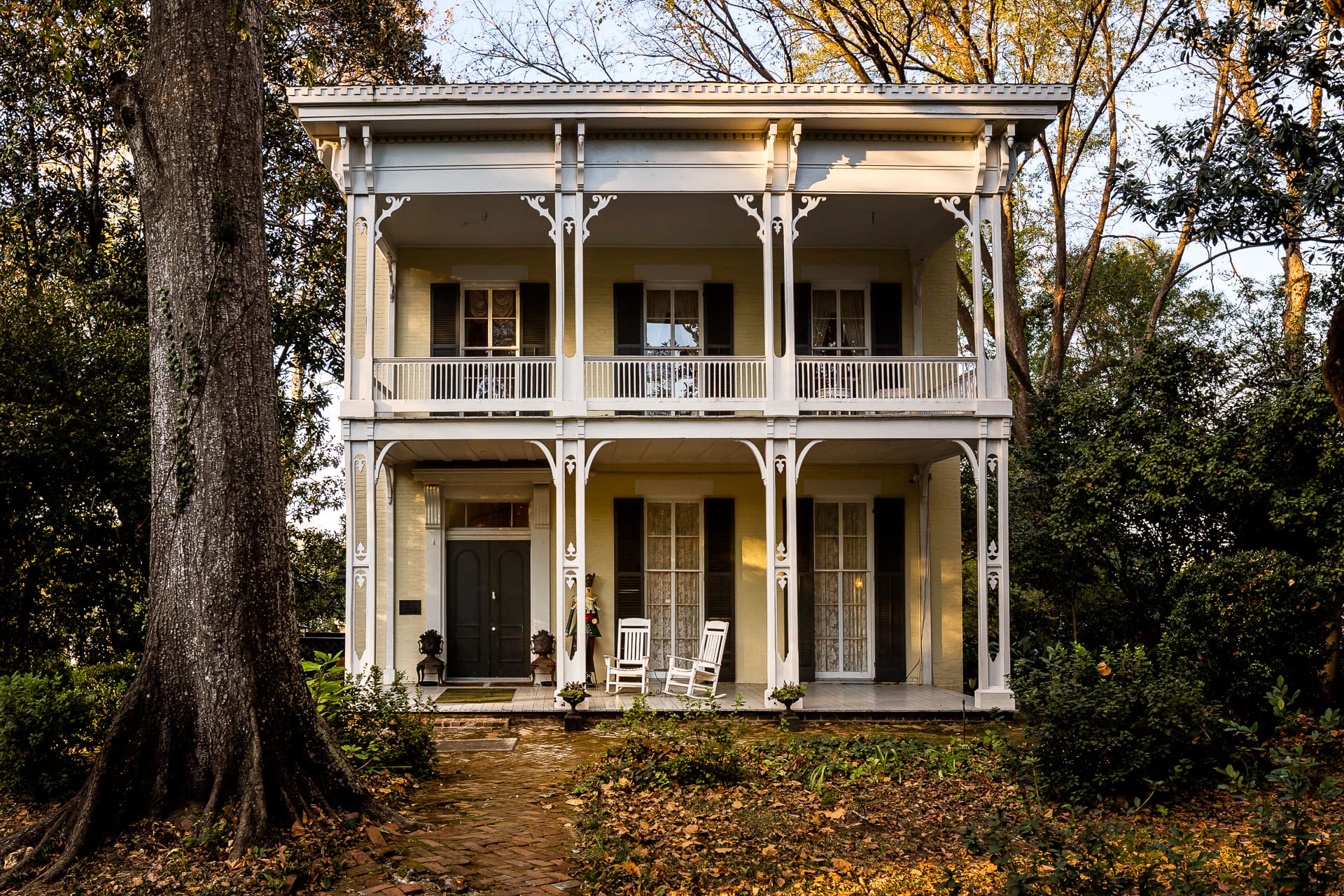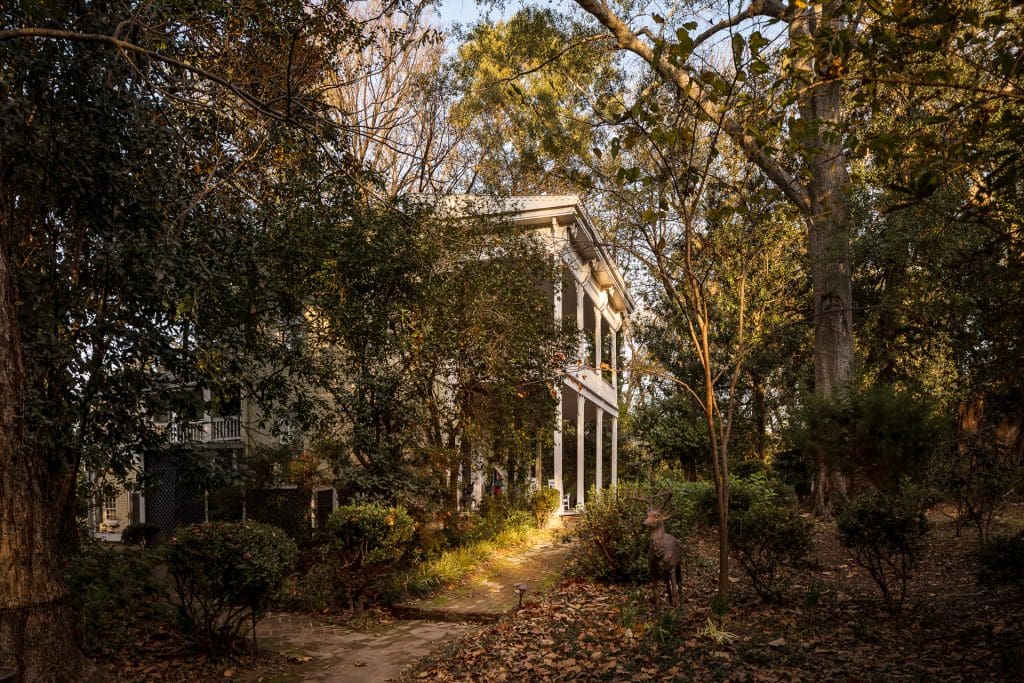McRaven (Bobb) House | Vicksburg, Mississippi

McRaven has been featured in LIFE Magazine, The Travel Channel, 48 Hours, and was dubbed National Geographic’s “Time Capsule of the South.” Most everyone else that knows the McRaven has dubbed her “The Most Haunted House in Mississippi.”
Countless newspapers, articles, videos and photos have been published about McRaven. After numerous investigations, Paranormal experts claim no fewer than 13 spirits make their presence known there. With such a great and rich history, it’s easy to see why.
The Legend of Origin
McRaven was built in 1797 by a man named Andrew Glass. Glass was a feared highwayman from the Murrell Gang with a growing reputation as the tales of his legendary robberies spread across the region.
If you haven’t heard of the Murrell Gang, you’re missing out. The history is quite a tale. Long-story-shot, John Murrell, also known as the Devil Reverend and accused of over 400 murders during his lifetime, was known for masquerading as a traveling preacher up and down the Natchez Trace (French Territory at the time). While sermonizing to his newly-found congregation, Glass and the rest of Murrell’s bandits would steal all the horses and valuables they could find, leaving only the horse Murrell rode in on.
At the time, McRaven was just a two-room hideout with a kitchen on the bottom floor and a sleeping area above. Glass didn’t want to get ambushed, so the only way to get up to the sleeping area was by a ladder that he would pull up with him every night before bed. I mean, to me, that doesn’t make a lot of fucking sense, but ok. They could just burn him out…..but anyway. On with the legend.
Like most criminals, luck eventually ran out. One night, Glass was on the prowl and he ended up on the wrong side of a gun. He was able to get back to McRaven in Spanish-held Fort Nogales (Vicksburg), but French soldiers were in hot pursuit. Forgoing their customary recognition of the line that separated their territory from that of the Spanish, the soldiers would find Glass in short order.
Bleeding out and in fear of being captured by the French, Glass convinced his wife to save him from that bleak future by ending his life. She obliged and slit his throat in the home that they spent so many nights together.
From there, the action simmers for about 30 years and the property had fallen into disrepair before being purchased in 1836 by Sheriff Stephen Howard. Stephen and his wife Elizabeth had decided to start there family there and, soon after, Elizabeth was pregnant.
The pregnancy had been uneventful and no one suspected any problems. Unfortunately, in that era, child birthing could quickly take a turn for the worst. In this instance, it did and Elizabeth died upstairs in the bed as the baby was born. Distraught and dismayed, Howard quickly moved out and sold the property to its next resident, John H. Bobb.
The Civil War and John Bobb
Bobb owned the property from 1837 until 1864. Prior to and during the 1863 Siege of Vicksburg, Bobb permitted his home to be used as a Confederate make-shift hospital. There, many soldiers died and will remain for eternity. Many of whom’s names were lost to history along with their lives.
With the Civil War still raging and the Union occupation of Vicksburg still ongoing, tensions were mounting in the city. They reached a boiling point for Bobb on May 18th, 1864. Union soldiers were picking flowers and vegetables from Bobb’s garden. Some reports say that they were also rummaging through his home. He yelled at the soldiers to leave. When they cursed and threatened Bobb, he took offense and retaliated. Finding the nearest object, Bobb picked up a brick and hurled it at one of the officers, hitting his mark and knocking out the soldier. Dragging their fallen comrade away from the property, the soldiers vowed revenge.
Later that day, more soldiers returned to the Bobb residence. They put Bobb and his nephew Austin Mattingly under arrest and informed them that they were to be escorted to Union General Slocum’s headquarters. The soldiers led the duo into a wooded area. It was at that moment Bobb and his nephew realized that they weren’t being taken to Slocum and attempted escape. Bobb was shot in the back and fell to the ground. The soldiers caught up to Bobb and finished the job with a bullet to the face. Amazingly, Mattingly escaped with no injuries, though his clothing was riddled with bullet holes.
Interesting Fact: John Bobb died intestate (no will) and a succession case was opened. John A. Klein, from our story about Cedar Grove, was appointed administrator of the estate until the case was settled.
John Bobb’s widow, Selina, sold McRaven several years after. William Murray, along with his wife and children, purchased the property in the early 1870’s. William Murray died in 1911, Ellen followed in 1921, daughter Ida in 1946, and a son in 1950. All reportedly passed away in the home.
The remaining daughters, Annie and Ella Murray, lived reclusive lives alone in the house with no modern conveniences (aside from a telephone) or contact with the outside world. In 1960, Ella Murray died at the age of 81 and her sister Annie sold the house to O. E. Bradway.
From there, the home changed hands several more times and underwent a couple of restorations before finally being opened to the public in 2015 for historical and paranormal tours.

The Hauntings
While experiences happen all over the home, the most common experiences tend to revolve around Mary Elizabeth Howard and her bedroom. The Bradways were frequently awakened by calls in the middle of the night informing them that lights were on at McRaven. People have reported seeing a teenage girl in the room, doors opening, and lights flickering in this room. For quite some time, her wedding shawl was on display in the home. Visitors have claimed to feel heat or even a presence pulling that shawl from their hands.
Several spirits have made their presence known as Confederate soldiers. At least 25 Civil War soldier’s remains are at McRaven. Some have said that they’ve seen gray-clad soldiers patrolling the grounds at night as if still on duty.
Leyland French, former owner and resident of McRaven, had many experiences in the home. There were a few experiences, though, that stood out more than others. One night, French saw a person on the staircase. Naturally, he was in a bit of shock, but quickly realized the person he saw. It was someone he’s seen every day in photos around the home, William Murray. Rattled, French ran to his bedroom and locked the door.
The experiences got progressively worse. While walking through the parlor, something unexplained pushed French face-first to the floor, breaking his glasses. A few stitches around his eye later, French was starting to worry about his safety in the home.
French’s most notable experience happened in his bedroom. I’ve seen mixed reports about the specifics, but it appears that French was getting clothes out of a dresser drawer. Resting his thumbs on the drawer as he was thought out his selections, the drawer slammed shut, breaking one of his thumbs.
At this point, French lived in perpetual anxiety of what could come next. He contacted a local Episcopal priest to have the house blessed, but French decided not to wait around the home any longer. He purchased a home down the street and sold McRaven. The blessing did appear to get rid negative activity in the home, but that doesn’t mean all activity stopped. Quite the contrary.
Once the property was reopened for tours with the new owners, tour guides began to have their own experiences.
Doors slam. Lights turn on and off. Alarms go off in the middle of the night. It’s constant. I took a break one day and was sleeping on the sofa in the entryway. I woke up to find Mr. Bobb looking down, staring at me as if I were one of those soldiers that led him to his death. I quit on the spot and never returned to the home.
In the old bedroom, I’ve seen the chair tilt back and slam forward. I’ve been scratched. Mr. Bobb has shown himself to me twice. Once, he appeared behind a tour I was giving. Another, I opened a door to find him standing there. In the 1836 bedroom, a door of the armoire open and shut itself in front of a tour group. Another time, in the same room, I was talking about Mary Elizabeth Howard. As i was talking, an impression was made on the bed as if someone sat there. It remained until I stopped talking about her. One other time, I walked in the same room to find a teenage girl looking out the window. She heard me, them turned and disappeared.
An audio/video clip from the home where an unexplained voice was caught: https://youtu.be/7zZGILEc9Js

The Truth
In 1797, Vicksburg hadn’t become Vicksburg yet. Vicksburg was a tiny place called Fort Nogales (nogales meaning “walnut trees”) still under Spanish rule. In 1798, after a treaty with Spain, America took control of the area and it was renamed to Walnut Hills. In 1814, a Methodist Minister named Newitt Vick moved to the area and purchased 1,180 acres of land (what is now downtown Vicksburg) from a man named Anthony Glass. Vick had intentions of building a city but, sadly, died of Yellow Fever with his wife in 1819. In 1825, Vick’s children helped incorporate the city and named it in honor of their father.
Anthony Glass was a carpenter at Fort Nogales and managed to acquire some land after the Spanish left. He was also a planter, producer and shipper of agricultural products, owner of a mill, and much more. Anthony, along with his brother Andrew, became very wealthy, well-known and well-respected in Vicksburg. In fact, Andrew Glass was so wealthy that he was one of the first citizens in Vicksburg to pay a luxury tax. Andrew was so well-known and respected that he served time as Sheriff of Warren County around 1822. Needless to say, I don’t think Andrew was the person that legend made him out to be.
There’s no evidence that any of the “highwayman” Andrew Glass stuff ever happened. I’ve searched for hours and hours on the subject, but I can’t find a single shred of evidence that confirms any of it. The only time I’ve ever seen this information is in retelling after retelling of the McRaven story. That doesn’t mean that the story isn’t true. It could be. There’s just no confirming evidence. No online photos, newspaper clippings, memoirs, deeds, etc.
The McRaven website says that Andrew Glass was a “highwayman that rode with the Murrell Gang”, but Murrell didn’t leave his home in Columbia, TN until 1821 at the age of 17. Even then, he didn’t go to Mississippi until some time later after a few stints in prison. A review of Murrell’s Mystic Clan members produces no one named Andrew Glass, A. Glass, Glass, or any variation of the name at all in any state.
Mary McCahon Shoemaker, the architectural historian that investigated McRaven for submission to the National Register of Historic Places, included the following in her paperwork dated November 6, 1978.
The land on which the Bobb House stands was originally part of the extensive holdings of Anthony Glass, an early settler in the area. As the riverport of Vicksburg grew, Glass’s holdings near the eastern boundary of the original town were subdivided. William Bobb purchased the 6.3-acre house lot in 1837 (Deed Book J:479) and may well have constructed the rear portion of the house before selling the property, enlarged to nearly eleven acres, to his brother John H. Bobb in 1844 for $5,000 (Deed Book U:598). Family tradition holds that John H. Bobb added the Italianate front section to the house (Critchler interview, June 1, 1978). Bobb’s widow, Selina, sold the property in 1869, and William Murray, a local machinist and inventor, acquired it in the early 1870s. Murray’s un-married daughters occupied the house until 1960, when it was sold to the present owner, O. E. Bradway, Jr. So overgrown that it was long forgotten, the property has undergone a careful restoration and preservation of house and grounds that continues under the owner’s direction.
You can view the report in its entirety, here.
To clarify, the name McRaven was given to the home in the latter half of the 20th Century. Historically, the home is known as the Bobb House and is listed in the National Register of Historic Places as such.
One oddity that sticks out to me is the omission of Sheriff Stephen Howard from the architectural historian’s report. Legend says that the Sheriff purchased the home in 1836 and his wife, Mary Elizabeth, died giving birth in the upstairs room shortly afterwards. The Sheriff was a real person. Mary Elizabeth was a real person and she died in late August of 1836. The home still contains some of her possessions (allegedly). Many people claim to see the apparition/impression of a woman in the upstairs bedroom where Elizabeth supposedly lost her life during childbirth.
Maybe they lived on the property? Maybe they rented? A section of McRaven was built around 1836, so that part of the story matches, but ownership records do not. As described in the Shoemaker report:
The earliest portion of the brick two-story house is the westward-facing rear ell constructed in two stages ca. 1836 in the conservative vernacular of the late Federal tradition.
Due to Howard’s involvement in the Murrell Excitement (he was Sheriff or Deputy Sheriff at the time), that would have added an additional layer of historical significance to the home that I doubt Shoemaker would have omitted. What’s the Murrell Excitement, you say? In as few words as possible, it was a plot by John Murrell and his gang to incite a slave rebellion in all the slave states. News of the rebellion plot spread across the South eventually sparking an incident in Vicksburg. Tensions were high in the city and there was a rumor that the professional gamblers in town were a part of the plot. An angry mob formed with the intentions of expelling the gamblers. The gamblers resisted and 5 of them were hanged by the mob. It’s considered the deadliest outbreak of extralegal violence in the South between Nat Turner’s Rebellion and The Civil War.
My Theory on the Origins of McRaven
Anthony Glass owned the land upon which McRaven currently sits. Around 1836, there was a small residence built by Glass, the Glass Family or an associate. Glass allowed Sheriff Howard to live on the property. When the Sheriff’s wife died in 1836, the Sherrif moved. Due to Sheriff Howard’s involvement with the Murrell Excitement, the stories got confused. John Murrell was the real highwayman. Anthony Glass became Andrew Glass. Andrew Glass absorbed the traits of John Murrell. Timelines were woven together. Boom. A legend is born.
Interesting fact: John Murrell was accused of over 400 murders during his lifetime. By the time he died of tuberculosis in 1844, the Great Western Land Pirate had mostly reformed in prison and confessed to most of the crimes attributed to him; except murder. Murrell claimed that he never murdered anyone. On his deathbed, Murrell reiterated that position and died saying that he never murdered a soul.
The Civil War Era
In 1837, William Bobb purchased the property from Anthony Glass. Seven years later, William Bobb sold McRaven to his brother John H. Bobb. As a redneck myself, I did take a moment to chuckle at the thought of “Billy” Bobb selling the property to John Bobb. I’m not sure that it gets more stereotypically redneck than that.
John Bobb lived uneventfully on the property until the Civil War broke out. McRaven made it relatively unscathed until the Siege of Vicksburg began in May of 1863. It was at this point that Bobb allowed his home to be used as a make-shift Confederate hospital. I’ve uncovered no fewer than 25 unknown Confederate Soldiers that call the McRaven house their final resting place. Like many homes and buildings from this period of time McRaven sustained some pretty severe cannon and rifle damage. There are 124 bullet holes in the parlor alone.
On July 4, 1863, Ulysses S. Grant traveled to John C. Pemberton’s Headquarters in Vicksburg (coincidentally, also built by William Bobb) to accept Confederate Surrender. Union Major General James B. McPherson chose the home next door to serve as his headquarters during the forthcoming occupation of Vicksburg. This home was also built by our buddy Bubba Billy Bobb and was known as the Balfour House. Civil War buffs will recognize that name. Emma Balfour kept a highly-detailed account of civilian life during the Siege of Vicksburg. Naturally, her proximity to Pemberton made the accounts full of fantastic historical information.
Nearly a year later, on May 18, 1864, the murder of Joh Bobb occurred.. The below was reported by the Vicksburg Herald:
John Bobb, a peaceable and unoffending citizen, has been most brutally murdered by negro soldiers. Ordering a lot of negroes out of his yard, where they were picking flowers, Bobb was cursed, abused, and insulted. He knocked down a negro sergeant, when they left vowing revenge. He immediately proceeded to headquarters and, after reporting the affair, was promised protection by General Slocum. When he went to his home some fifteen or twenty negro soldiers, led by a sergeant, arrested him and a Mr. Mattingly, who was with him. He was taken through the machine shops and 150 rods down the bayou when a negro shot him in the back. He fell and another shot struck his face. Mattingly ran and was pursued and shot at. Gen. Slocum sent one of his staff to ascertain the facts. He found Bobbs dead, his distracted wife hanging over his body, surrounded by 100 negro soldiers who shouted, “we’ve got them now.” He ordered the arrest of all the parties, but up to this writing the sergeant alone has been arrested. If Gen. Slocum does not find out and hang these men there is no security for life to any man, and he is unfit for the command.”
This account is true, but it does leave out a major fact. The “peaceable and unoffending citizen” John Bobb hit one of the soldiers with a brick. That seems to be an irrefutable fact from the reports I’ve read. Not a good move. Union General Slocum faulted Bobb for the confrontation but decried the violent act of his soldiers in his General Orders No. 7. The soldiers were never punished. This event is significant in Civil War History because it marks the first time a Vicksburg civilian was killed as a result of mounting tensions between the city and its occupying Union forces. It’s also, reportedly, the first time a white man was killed by black reconstruction/occupation soldiers.
Other than these items, I’ve been unable to find any evidence that clearly contradicts the other stories about McRaven. My theories could be wrong and my contradictory evidence could be wrong….but I did the best I could with the resources I had available.
